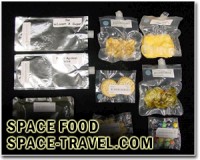 |
Paris, France (ESA) Nov 11, 2010 It's small, but it's a greenhouse for space voyagers - and for you. Paolo Nespoli will take a special greenhouse with him to the International Space Station and he's inviting young science enthusiasts to conduct an experiment with him. Growing plants in space will be crucial for the astronauts of the future. When flying to Mars or even further, it will be necessary to produce fresh food onboard and become partially self-sufficient. Setting up greenhouses on the Moon, Mars or other planetary bodies will also be an important part of future exploration missions. Greenhouses also provide oxygen and bring some life to the bleakness of space. Caring for plants is a good way to maintain memories of Earth and an enjoyable way to pass time during the long and possibly boring interplanetary cruise.
Plants aboard the ISS Paolo will use a specially-developed greenhouse in space to grow plants and make observations of the life cycle of a flowering plant. The schoolchildren will be able to follow this with their own experiment on the ground, using a similar greenhouse and the same species of plant. The experiment starts with watering of some thale cress (Arabidopsis thaliana) set up in the International Space Station's Columbus laboratory. The children will start their own ground experiments at the same time. Paolo will take still images of the growth cycle and video recordings of key steps in the germination of the plants and post them on the MagISStra website. The participating children will be able to compare the space experiment with their ground experiment. The young scientists on the ground and Paolo in orbit will follow the growth cycle of their flowering plants for about 10 weeks. The children will be encouraged to exchange their observations with each other over this period, creating a Europe-wide network that enables one experiment to link young scientists together in a special way.
Order your own greenhouse! The instructions can be downloaded in 13 languages from ESA's Human Spaceflight education website as from January 2011. The children will be invited to send their end results and observations to the ESA Human Space Flight education team, who will create a final lesson online for download by other schools and teachers. The experiment will be launched in mid February 2011 with a live event linking together nearly 750 children in four locations in Europe: the European Astronaut Centre in Cologne, Germany; ESRIN in Frascati, Italy; Cite de l'Espace in Toulouse, France; and Ciencia Viva - Agencia Nacional para a Cultura Cientifica e Tecnologica in Lisbon, Portugal. Paolo will of course particpate in the event from the Space station which will have its own minature greenhouse.
Share This Article With Planet Earth
Related Links MagISStra at ESA Space Tourism, Space Transport and Space Exploration News
 Cosmonaut food prices skyrocket due to inflation: official
Cosmonaut food prices skyrocket due to inflation: officialMoscow (AFP) Oct 21, 2010 The price of food rations on board the International Space Station (ISS) has increased by nearly 50 percent over the past year due to inflation, a Russian official said on Thursday. "Last year, the cosmonaut's daily ration in space cost about 11,000 rubles (250 euros), and today the cost is reaching 15,000 rubles," Viktor Dobrovolsky, director of the food institute that supplies space cosmon ... read more |
|
| The content herein, unless otherwise known to be public domain, are Copyright 1995-2010 - SpaceDaily. AFP and UPI Wire Stories are copyright Agence France-Presse and United Press International. ESA Portal Reports are copyright European Space Agency. All NASA sourced material is public domain. Additional copyrights may apply in whole or part to other bona fide parties. Advertising does not imply endorsement,agreement or approval of any opinions, statements or information provided by SpaceDaily on any Web page published or hosted by SpaceDaily. Privacy Statement |